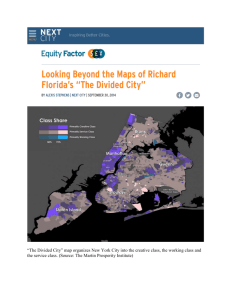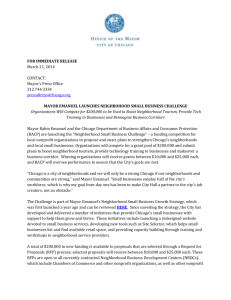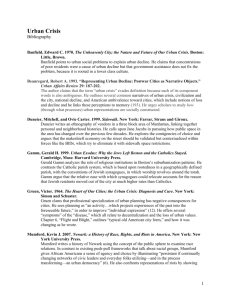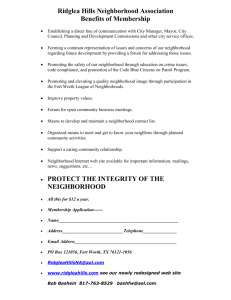Das & Claessens
advertisement
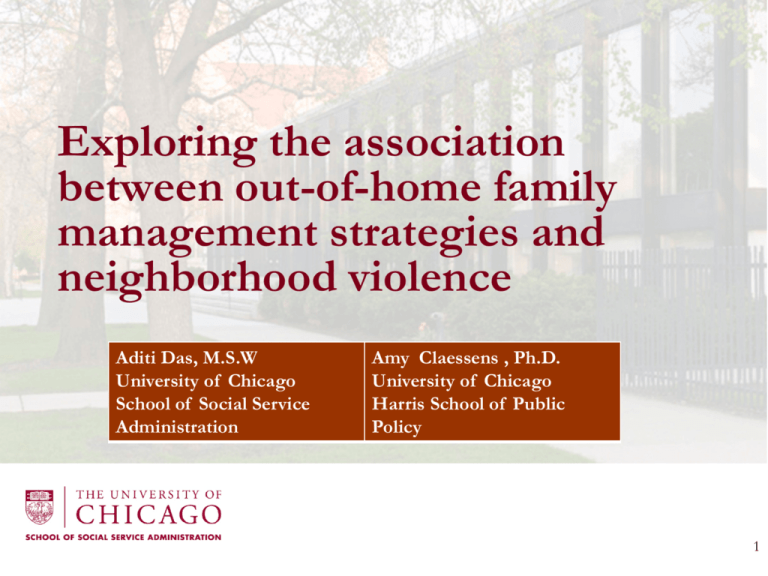
Exploring the association between out-of-home family management strategies and neighborhood violence Aditi Das, M.S.W University of Chicago School of Social Service Administration Amy Claessens , Ph.D. University of Chicago Harris School of Public Policy 1 Crime and Violence in Chicago 16-year-old killed at party; 6 others wounded in weekend violence SUN-TIMES MEDIA January 12, 2014 9:29AM - Rich Schapiro, New York Daily News, Feb 24,2013 - Jamilah King, Color Lines News for Action Feb 07,2013 How Chicago Points to a Growing Inequality of Urban Violence- Noah Berlatsky Oct 03, 2013 2 Literature Review • Despite high risks, research has demonstrated that parents have the ability to prevent their children’s engagement in negative behaviors in the community (Rankin & Quane, 2002; Walsh Harel-Fisch & Fogel-Grinvald, 2010) • Family and neighborhood contexts, particularly social capital can influence supportive parenting techniques (Rankin & Quane, 2002) • Parenting processes are embedded in larger community contexts and the specific pathways through which social capital can affect parenting are multiple and nuanced (Jencks & Mayer, 1990; Sampson, 1997) • Duncan & Raudenbush (2001) assert that families may serve as mediators between community contexts and youth developmental trajectories 3 Theoretical Framing Coleman and Putnam’s social and human capital framing • Putnam (1995): The collective value of social networks and emphasis on social cohesion • Coleman (1990): Relational networks, social trust and norms 4 Furstenberg’s Conceptual Framework 5 Out-of-Home Family Management Strategies • Promotive : Strategies that foster children’s talents and opportunities by exposing them to structured learning situations – – – – Children’s activity involvement Skill building Shared activity involvement Level of autonomy/democratic decision making • Protective/Preventive : Strategies that reduce children’s exposure to various types of dangerous circumstances. – Restrict mobility and friendship networks – Discipline effectiveness and consistency – Take them outside the neighborhood 6 Research Questions Within high crime and poverty neighborhoods in Chicago • Does the preventive/ promotive distinction suggested by Furstenberg and colleagues accord with parental caregiving strategies? • What factors may shape the out-of-home family management strategies employed? 7 Data Source • “The Causes of Truancy and Dropout: A Mixed-Methods Experimental Study in Chicago Public Schools”, a large scale experiment to test if the Check and Connect structured monitoring and mentoring program is designed to strengthen youth connections to school and other social settings. • Qualitative component of the study was used to understand the social processes and mediating mechanisms through which Check and Connect affects schooling outcomes for at-risk youth based on their relationships within and across settings such as family, school, neighborhood and peers. 8 Sample and Method • Using a stratified random sample, parents or guardians of elementary school children between 1st and 8th grade who experienced high rates of absenteeism from Chicago Public Schools and are receiving the treatment (N=31 ) • In-home semi structured interviews wherein the sample was predominantly Black residing in disadvantaged neighborhoods on the south and west sides of Chicago • Data Analysis Plan: Employed content analysis guided by deductive theme development was undertaken with the aid of NVivo10. Conceptually clustered matrices were then constructed to detect patterns in themes across interviews. 9 Demographic summary of findings • Majority of sample (94%) is female with an almost equal number of married and single women • The average number of children is 3 per household • The median length of residential stay is 3 years with a large range of 2 months to 41 years • 68% of households are renters while the rest are owners • 61% of the sample is employed in jobs like Personal Nurse Assistants, Security, Cleaners, Store Managers etc. 10 Perceptions about neighborhood and school safety • Too much to let any child right now…people are dropping like flies with teenagers doing most of the shooting in their area- Dave • I bring up something so they won’t be able to go out, uh, it’s, it’s so, so, so dangerous and a lotta things happen, and we don’t live in the best of neighborhoods- Linda • There’s just too much, too ghetto around here.- Alicia • And I know she, she came home one time and said a kid pulled a knife on her at the school, they had him arrested though. – Sandra 11 Protective/Preventive strategies Disciplinary enforcement • Enforce rules • Punish child for creating problems • Point out how danger impacts lives • Teach child to use good judgment Restrictive strategies • Chaperon especially to and from school • Lock in/ground child • Sever friendships • Monitor and supervise child’s activities Remove from context • Take child out of the situation 12 Protective/Preventive strategies Disciplinary enforcement Taught my children to be wary of strangers, you'd best listen to your momma. –Katy But when somebody touches her she gets defensive or she wants to fight. And I’ve already explained to her you can't do that, you’re older now, they can have you arrested. -Sandra 13 Protective/Preventive strategies Restrictive Strategies I mean cause you can’t, really they can’t go nowhere. They can’t even ride to go to school without something happening.Andrea Well her friends don’t really come over because I don't know, I don't trust them. I’m like no, my daughter’s not going out there because I know there’s gang members out there too, and I don’t want my daughter involved in none of that stuff- Sandra 14 Protective/Preventive strategies Remove child from context I mean somebody really gets shot around here almost every other day like, so around here we don’t go out at all. When we leave this house we’re elsewhere.- Dave Yeah. Yeah. I take the baby and we go out there a lot to his house. He has his own house.- Katy. 15 Promotive strategies Activity involvement Skill Building • Help with • Build on child’s homework talent/interest • Regular • Sign them up for communication with activities like afterschool authorities school programs • Take to Church • Network with others • Engage children for child’s benefit with after-school programs Support of Autonomy • Engage in democratic decision making within families • Entrusted with family responsibilities 16 Promotive strategies Activity involvement Tuesdays and Thursdays, I request those off, those mostly uh where we guide it towards our family days.- Dave I, I’ve coached all of my kids, you know I’ve coached my, I was coaching my son, now he’s going into high school now and I coached his little league seven, for seven years, my daughter –Leon She goes to activities at the church when they have them on Tuesdays. Like they’ll go out, like they’ll take them ice skating and roller skating and stuff like that-Sandra 17 Promotive strategies Skill building Um, right now, uh we, we making plans, uh he’s very interested in the law for some reason, somebody put that in his head. So we been planning trips, law library, uh, on the internet he looks at uh, a lot of law material in there, um, I, I’m fixing to get this uh, (laughs) the test to become a lawyer- Dave But I think he’ll go all the way, he wanna be a football player. They don’t even have that there, so I’m thinking about putting him in a camp.. - Alicia 18 Promotive strategies Support of autonomy Yeah, she, she does, she, she take care of, of the, the youngest ones, you know, I think um, now that I don’t have a car anymore, they um, she’s uh, taken on responsibility and she’s, she’s not as bad as sh-, she used to be with them. –Linda 19 Mix of preventive and promotive strategies • Maintain daily routine • Selection of Children’s Schools • Creation of a “functional” neighborhood 20 Factors shaping strategies employed • • • • • • • Kin social support; trust issues Historical and cultural ties to their neighborhoods Prior exposure to violent conditions/personal bereavement Age and gender of child Individual human capital Educating children about safety Communities as co-socializers 21 Discussion • Furstenberg’s strategies employed are applicable to this study with the addition of a mix of key strategies • Despite neighborhood adversity, majority of the parents (mostly single mothers) reported reasonably high levels of active out-of-home family management practices • Parental adoption of either the protective or promotive activity is related to Coleman and Putnam’s theory of social capital based on the social networks and institutional measures parent’s can garner • Parent’s exert exceptional control and efficacy in these neighborhoods to protect their children from dangers and risks in their communities 22 Implications and Future Research • Understanding the parenting processes within violent environments has important implications for children’s growth and school success. • Restrictiveness and investment appear to be the most practical options for parents living in poor minority neighborhoods but may come to be resented by children especially adolescents • The study suggests on improving community based institutional supports and programs for parents to engage in more positive, promotional strategies for their children • Use an appropriate large scale data set to learn if such trends hold true and design interventions beneficial to families residing in 23 violent, poor neighborhood contexts Exploring the association between out-of-home family management strategies and neighborhood violence Aditi Das, MSW Amy Claessens, PhD aditidas@uchicago.edu amyc1@uchicago.edu
